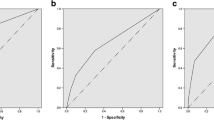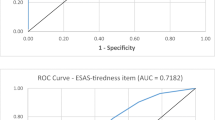ABSTRACT
BACKGROUND
Sleep disturbance is a significant problem for adults presenting to primary care. Though it is recommended that primary care providers screen for sleep problems, a brief, effective screening tool is not available.
OBJECTIVE
The aim of this preliminary study was to test the utility of item three of the Patient Health Questionnaire-9-item (PHQ-9) as a self-report screening test for sleep disturbance in primary care.
DESIGN
This was a cross-sectional survey of male VA primary care patients in Syracuse and Rochester, NY. Sensitivity and specificity statistics were calculated as well as positive and negative predictive value to determine both whether the PHQ-9 item-3 can be used as an effective sleep screen in primary care and at what PHQ item-3 cut score patients should be further assessed for sleep disturbance.
PARTICIPANTS
One hundred and eleven male, VA primary care patients over the age of 18 and without gross neurological impairment participated in this one-session, in-person study.
MEASURES
During the research session, patients completed several questionnaires, including a basic demographic questionnaire, the PHQ-9, and the Insomnia Severity Index (ISI).
KEY RESULTS
PHQ-9 item 3 significantly correlated with the total score on the ISI (r = 0.75, p < 0.0001). A cut score of 1 on the PHQ-9 item 3, indicating sleep disturbance at least several days in the last two weeks, showed the best balance of sensitivity (82.5%) and specificity (84.5%) as well as positive (78.4%) and negative (91%) predictive value.
CONCLUSIONS
Item 3 of the PHQ-9 shows promise as a screener for sleep problems in primary care. Using this one-item of a popular screening measure for depression in primary care allows providers to easily screen for two important issues without unnecessarily adding significant burden.

Similar content being viewed by others
References
Alattar M, Harrington JJ, Mitchell CM, Sloane P. Sleep problems in primary care: a North Carolina Family Practice Research Network (NC-FB-RN) study. J Am Board Fam Med. 2008;20:365–74.
Karachaliou F, Kostikas K, Pastaka C, Bagiatis V, Gourgoulianis KI. Prevalence of sleep-related symptoms in a primary care population—their relation to asthma and COPD. Prim Care Respir J. 2007;16:222–8.
Leshner A, Baghdoyan H, Bennett S, et al. Final statement from the NIH “State-of-the-Science Conference” on manifestations and management of chronic insomnia in adults. Sleep. 2005;28:1049–1057.
Simon GE, VonKorff M. Prevalence, burden and treatment of insomnia in primary care. Am J Psychiatry. 1997;154:1417–1423.
Pigeon WR, Heffner K, Duberstein P, et al. Elevated sleep disturbance among blacks in an urban family medicine practice. J Am Board Fam Med. 2011;24:161–8.
Shochat T, Umphress J, Israel AG, Acoli-Israel S. Insomnia in primary care patients. Sleep. 1999;22(Suppl 2):S359–65.
Partinen M, Hublin C. Epidemiology of sleep disorders. In: Kryger M, Roth T, Dement W, eds. Principles 7 practice of Sleep medicine 5th Edition. St. Louis: Elsevier; 2010.
Hasler G, Buysse DJ, Gamma A, et al. Excessive daytime sleepiness in young adults: a 20-year prospective community study. J Clin Psychiatry. 2005;66:521–9.
Katz DA, McHorney CA. The relationship between insomnia and health-related quality of life in patients with chronic illness. J Fam Pract. 2002;51:229–35.
Léger D, Guilleminault C, Bader G, Lévy E, Paillard M. Medical and socio-professional impact of insomnia. Sleep. 2002;15:625–9.
Pigeon WR. Insomnia as a risk factor for disease. In: Sateia MJ, Buysse D, eds. Insomnia: diagnosis and treatment. New York: Informa Healthcare; 2010.
Rakel RE. Clinical and societal consequences of obstructive sleep apnea and excessive daytime sleepiness. Postgrad Med. 2009;121:86–95.
Roth T, Franklin M, Bramley TJ. The state of insomnia and emerging trends. Am J Manag Care. 2007;13:S117–20.
Skaer TL, Sclar DA. Economic implications of sleep disorders. Pharmacoeconomics. 2010;28:1015–23.
Fullerton DS. The economic impact of insomnia in managed care: a clearer picture emerges. Am J Manag Care. 2006;12(8 Suppl):S246–52.
Hillman DR, Murphy AS, Pezzullo L. The economic cost of sleep disorders. Sleep. 2006;29:299–305.
Ozminkowski RJ, Wang S, Walsh JK. The direct and indirect costs of untreated insomnia in adults in the United States. Sleep. 2007;30:263–73.
Tubtimtes S, Sukying C, Prueksaritanond S. Sleep problems in out-patient of primary care unit. J Med Assoc Thai. 2009;92:273–8.
Walsh JK, Benca RM, Bonnet M, et al. Insomnia: assessment and management in primary care. National Heart, Lung, and Blood Institute working group on insomnia. Am Fam Physician. 1999;59:3029–38.
Doghramji PP. Detection of insomnia in primary care. J Clin Psychiatry. 2001;62(Suppl 10):S18–26.
Morin CM, Hauri PJ, Espie CA, Spielman AJ, Buysse DJ, Bootzin RR. Nonpharmacologic treatment of chronic insomnia. Sleep. 1999;22:1134–56.
Mitty E, Flores S. Sleepiness or excessive daytime somnolence. Geriatr Nurs. 2009;30:53–60.
Boulos MI, Murray BJ. Current evaluation and management of excessive daytime sleepiness. Can J Neurol Sci. 2010;37:167–176.
Preventive Services US. Task Force. Screening for depression in adults: U.S. Preventive Services Task Force recommendation statement. Ann Intern Med. 2009;151:784–792.
Kroenke K, Spitzer RL, Williams JBW. The PHQ-9: validity of a brief depression severity measure. J Gen Intern Med. 2001;16:606–13.
Nease DE Jr, Malouin JM. Depression screening: a practical strategy. J Fam Practice. 2003;52:118–24.
Morin CM. Insomnia: psychological assessment and management. New York: Guilford Press; 1993.
Veteran’s Health Administration, Available at http://vaww4.va.gov/vhaopp/VHA_OP_Plan/2011_13/Improve_Veterans_mental_health.pdf. Accessed on December 16, 2010
Tew J, Klaus J, Oslin DW. The behavioral health laboratory: building a stronger foundation for the patient-centered medical home. Fam Syst Health. 2010;28:130–45.
Bush KR, Kivlahan DR, McDonnell MB, Fihn SD, Bradley KA. The AUDIT alcohol consumption questions (AUDIT-C): an effective brief screening test for problem drinking: Ambulatory Care Quality Improvement Project (ACQUIP): alcohol use disorders identification test. Arch Intern Med. 1998;158:1789–95.
Bastien CH, Vallieres A, Morin CM. Validation of the ISI as an outcome measure for insomnia severity. Sleep Med. 2001;2:297–307.
WHO. International Statistical Classification of Diseases and Health Related Problems, ICD-10. Geneva: World Health Organization; 2000.
Morin CM, Belleville G, Belanger L, Ivers H. The insomnia severity index: psychometric indicators to detect insomnia cases and evaluate treatment response. Sleep. 2011;34:601–8.
Saunders JB, Aasland OG, Babor TF, De La Fuente JR, Grant M. Development of the Alcohol Use Disorders Identification Test (AUDIT): WHO collaborative project on early detection of persons with harmful alcohol consumption-II. Addiction. 1993;88:791–804.
Prins A, Ouimette P, Kimerling R, et al. The primary care PTSD screen (PC-PTSD): development and operating characteristics. Primary Care Psychia. 2003;9:9–14.
Bliese PD, Wright KM, Adler AB, et al. Validating the Primary Care Posttraumatic Stress Disorder Screen and the Posttraumatic Stress Disorder Checklist with soldiers returning from combat. J Consult Clin Psych. 2008;76:272–81.
Fetveit A. Late-life insomnia: a review. Geriatr Gerontol Int. 2009;9:220–34.
Neikrug AB, Ancoli-Israel S. Sleep disorders in the older adult—a mini review. Gerontology. 2010;56:181–9.
Krishnan V, Collop NA. Gender differences in sleep disorders. Curr Opin Pulm Med. 2006;12:383–9.
Peretti-Watel P, Legley S, Baumann M, et al. Fatigue, insomnia, and nervousness: gender disparities and roles of individual characteristics and lifestyle factors among economically active people. Soc Psychiatry Psychiatr Epidemiol. 2009;44:703–9.
Cohen, J. Statistical power analysis for the behavioral sciences (2nd ed.). Hillsdale, NJ: Erlbaum; 1988.
Bliwise DL, King AC, Harris RB, Haskell WL. Prevalence of self-reported poor sleep in a healthy population aged 50–65. Soc Sci Med. 1992;34:49–55.
Ohayon MM, Carskadon MA, Guilleminault C, Vitiello MV. Meta-analysis of quantitative sleep parameters from childhood to old age in healthy individuals: developing normative sleep values across the human lifespan. Sleep. 2004;27:1255–73.
Mellman TA. Sleep and posttraumatic stress disorder: a road map for clinicians and researchers. Sleep Med Rev. 2008;12:165–7.
Morin CM, Culbert JP, Schwartz SM. Nonpharmacological interventions for insomnia: a meta-analysis of treatment efficacy. Am J Psychiatry. 1994;151:1172–80.
Berger AM, Kuhn BR, Farr LA, et al. One-year outcomes of a behavioral therapy intervention trial on sleep quality and cancer-related fatigue. J Clin Oncol. 2009;27:6033–40.
Currie SR, Wilson KG, Pontefract AJ, de Laplante L. Cognitive-behavioral treatment of insomnia secondary to chronic pain. J Consult Clin Psych. 2000;68:407–16.
Edigner JD, Wohlgenuth WK, Krystal AD, Rice JR. Behavioral insomnia therapy for fibromyalgia patients. Arch Intern Med. 2005;165:2527–35.
Edinger JD, Olsen MK, Stechuchak KM, et al. Cognitive behavioral therapy for patients with primary insomnia or insomnia associated predominately with mixed psychiatric disorders: a randomized clinical trial. Sleep. 2009;32:499–510.
Ulmer CS, Edinger JD, Calhoun PS. A multi-component cognitive-behavioral intervention for sleep disturbance in veterans with PTSD: a pilot study. J Clin Sleep Med. 2011;7:57–68.
Fava M, McCall WV, Krystal A, et al. Eszopiclone co-administered with fluoxetine in patients with insomnia coexisting with major depressive disorder. Biol Psychiatry. 2006;59:1052–60.
Junquist CR, O’Brien C, Matteson-Rusby S, et al. The efficacy of cognitive-behavioral therapy for insomnia in patients with chronic pain. Sleep Med. 2010;11:302–9.
Manber R, Edinger JD, Gress JL, et al. Cognitive behavioral therapy for insomnia enhances depression outcome in patients with comorbid major depressive disorder. Sleep. 2008;31:489–495.
Bewick V, Cheeck L, Ball J. Statistics review 13: receiver operating characteristic curves. Crit Care. 2004;8:508–512.
Stein MD, Friedmann PD. Disturbed sleep and its relationship to alcohol use. Subst Abus. 2005;26:1–13.
Bliwise DL. Sleep apnea, APOE4 and Alzheimer’s disease 20 years and counting? J Psychosom Res. 2002;53:539–46.
Pamidi S, Aronsohn RS, Tasali E. Obstructive sleep apnea: role in the risk and severity of diabetes. Best Pract Res Cl. 2010;24:703–15.
Reishtein JL. Obstructive sleep apnea: a risk factor for cardiovascular disease. J Cardiovasc Nurs. 2011;26:106–16.
Contributors
The views expressed in this article are those of the authors and do not reflect the official policy of the Veteran’s Affair’s department or other departments of the U.S. government. We acknowledge the Center for Integrated Healthcare, Syracuse VA Medical Center (VAMC) who contributed support to this research study.
Funders
This material is based upon work supported by the Department of Veterans Affairs, Veterans Health Administration, and the Center for Integrated Healthcare.
Prior Presentations
The material discussed in this paper has not been a part of any prior presentations.
Conflict of Interest
None disclosed.
Author information
Authors and Affiliations
Corresponding author
Rights and permissions
About this article
Cite this article
MacGregor, K.L., Funderburk, J.S., Pigeon, W. et al. Evaluation of the PHQ-9 Item 3 as a Screen for Sleep Disturbance in Primary Care. J GEN INTERN MED 27, 339–344 (2012). https://doi.org/10.1007/s11606-011-1884-5
Received:
Revised:
Accepted:
Published:
Issue Date:
DOI: https://doi.org/10.1007/s11606-011-1884-5




